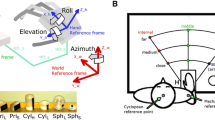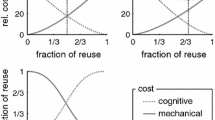Abstract
We have documented before that human grasping movements executed in an everyday-like context differ from those in a typical laboratory context. The differences were reduced by factor analysis to five orthogonal factors; we took this as evidence that at least five distinct sensorimotor functions are context-dependent. To better understand how context exerts its influence on the sensorimotor system, we now evaluate the relationship between context-dependence and cognitive abilities. Forty subjects participated in a laboratory task (L) where grasping was explicitly instructed, externally triggered, repetitive, and served no higher ecologically valid purpose, or in an everyday-like task (E) where the movements were implicitly instructed, volitional, part of a behavioral sequence, and served a valid purpose. We registered a wide range of kinematic, force, and gaze parameters. Subjects also completed a battery of cognitive tests. We observed multiple task-related differences between grasping parameters, which could be reduced to five orthogonal factors by factor analysis with varimax rotation. Cognitive scores could also be reduced to five orthogonal factors. Five significant correlations between cognitive and grasping factors were observed and could be attributed to a linkage of cognitive abilities with E, with L, or with both tasks. Our data confirm that grasping movements are context-dependent and that this dependence can be traced back to five orthogonal factors. The observed correlations between cognitive and grasping factors are consistent with the view that behavioral context influences the distribution of processing between the ventral and the dorsal cortical stream.


Similar content being viewed by others
Notes
When the selection of parameters for factor analysis was based on Bonferroni-corrected rather than original p values, the number of parameters decreased to 10 (see Table 2) and the number of extracted factors to 4: GF1, GF2, GF4 and GF5 emerged with closely similar loadings as in the original analyses, while GF3 was absent.
References
Ackerman PL (1987) Individual differences in skill learning: an integration of psychometric and information processing perspectives. Psychol Bull 102:3–27
Ackerman PL (1988) Determinants of individual differences during skill acquisition: cognitive abilities and information processing. J Exp Psychol Gen 117:288–318
Adam JJ, Nieuwenstein JH, Huys R, Paas FGWC, Kingma H, Willems P, Werry M (2000) Control of rapid aimed hand movements: the one-target advantage. J Exp Psychol Hum Percept Perform 26:295–312
Ansuini C, Santello M, Massaccesi S, Castiello U (2006) Effects of end-goal on hand shaping. J Neurophysiol 95:2456–2465
Ansuini C, Giosa L, Turella L, Altoè G, Castiello U (2008) An object for an action, the same object for other actions: effects on hand shaping. Exp Brain Res 185:111–119
Bennett KMB, Castiello U (1995) Reorganization of prehension components following perturbation of object size. Psychol Aging 10:204–214
Bock O (2010) Sensorimotor adaptation is influenced by background music. Exp Brain Res 203:737–741
Bock O, Arnold K (1992) Motor control prior to movement onset: preparatory mechanisms for pointing at visual targets. Exp Brain Res 90:209–216
Bock O, Beurskens R (2011) Effects of a visual distracter task on the gait of elderly versus young persons. Curr Gerontol Geriat Res. doi:10.1155/2011/651718
Bock O, Hagemann A (2010) An experimental paradigm to compare motor performance under laboratory and under everyday-like conditions. J Neurosci Meth 193:24–28
Bock O, Steinberg F (2012) Age-related deficits of manual grasping in a laboratory versus in an everyday-like setting. Ageing Res 3:48–52
Boussaoud D, di Pellegrino G, Wise SP (1995) Frontal lobe mechanisms subserving vision-for-action versus vision-for-perception. Behav Brain Res 72:1–15
Bullier J, Schall JD, Morel A (1996) Functional streams in occipito-frontal connections in the monkey. Behav Brain Res 76:89–97
Buxbaum LJ, Johnson-Frey SH, Bartlett-Williams M (2005) Deficient internal models for planning hand-object interactions in apraxia. Neuropsychol 43:917–929
Castiello U (1996) Grasping a fruit: selection for action. J Exp Psychol Hum Percept Perform 22:582–603
Castiello U, Bennett KMB, Paulignan Y (1992) Does the type of prehension influence the kinematics of reaching. Behav Brain Res 50:7–15
Castiello U, Bennett KMB, Stelmach GE (1993) Reach to grasp: the natural response to perturbation of object size. Exp Brain Res 94:163–178
Castiello U, Bennett K, Chambers H (1998) Reach to grasp: the response to a simultaneous perturbation of object position and size. Exp Brain Res 120:31–40
Cattell RB (1966) The scree test for the number of factors. Multivar Behav Res 1:245–276
Chamberlin C, Magill R (1989) Preparation and control of rapid, multisegmented responses in simple and choice environments. Res Q Exerc Sport 60:256–267
Cohen NR, Cross ES, Tunik E, Grafton ST, Culham JC (2009) Ventral and dorsal stream contributions to the online control of immediate and delayed grasping: a TMS approach. Neuropsychology 47:1553–1562
Creem SH, Proffitt DR (2001) Grasping objects by their handles: a necessary interaction between cognition and action. J Exp Psychol Hum Percept Perform 27:218–228
Daprati E, Sirigu A (2006) How we interact with objects: learning from brain lesions. Trends Cogn Sci 10:265–270
Gentilucci M, Gangitano M (1998) Influence of automatic word reading on motor control. Eur J Neurosci 10:752–756
Glasscock NF, Mirka GA, Sommerich CM, Klein KW (2002) The effect of personality type on assembly time and wrist kinematics during a laboratory task. Proc Hum Fac Ergonom Soc Ann Meet 46:1105–1109
Glover S, Rosenbaum D, Graham J, Dixon P (2004) Grasping the meaning of words. Exp Brain Res 154:103–108
Goodale MA, Milner AD (1992) Separate visual pathways for perception and action. Trends Neurosci 15:20–25
Grafton S (2010) The cognitive neuroscience of prehension: recent developments. Exp Brain Res 204:475–491
Henry F, Rogers D (1960) Increased response latency for complicated movements and a “memory drum” theory of neuromotor reaction. Res Q 31:448–458
Hesse C, Franz VH (2009) Corrective processes in grasping after perturbations of object size. J Motor Behav 41:253–273
Himmelbach M, Karnath H-O (2005) Dorsal and ventral stream interaction: contributions from optic ataxia. J Cogn Neurosci 17:632–640
Holtzer R, Verghese J, Xue X, Lipton RB (2006) Cognitive processes related to gait velocity: results from the Einstein aging study. Neuropsychology 20:215–223
Horn JL (1965) A rationale and test for the number of factors in factor analysis. Psychometrika 30:179–185
Jeannerod M (1981) Intersegmental coordination during reaching at natural visual objects. In: Long J, Baddeley A (eds) Attention and performance. Lawrence Erlbaum, Hillsdale, pp 153–168
Jeannerod M, Decety J, Michel F (1994) Impairment of grasping movements following a bilateral posterior parietal lesion. Neuropsychology 32:369–380
Kaiser HF (1960) The application of electronic computers to factor analysis. Educ Psychol Meas 20:141–151
Knierim JJ, Van Essen DC (1992) Visual cortex: cartography, connectivity, and concurrent processing. Curr Opin Neurobiol 2:150–155
Kuhl J, Kazen M (2009) PSSI Persönlichkeits-Stil-und Störungsinventar. Hogrefe, Göttingen
Marras WS, Davis KG, Heaney CA, Maronitis AB, Allread WG (2000) The influence of psychosocial stress, gender, and personality on mechanical loading of the lumbar spine. Spine 25:3045–3054
Marteniuk RG, Mackenzie CL, Jeannerod M, Athenes S, Dugas C (1987) Constraints on human arm movement trajectories. Can J Psychol 41:365–378
Milner AD, Goodale MA (1995) The visual brain in action. Oxford University Press, New York
Miyake A, Friedman NP, Emerson MJ, Witzki AH, Howerter A, Wager TD (2000) The unity and diversity of executive functions and their contributions to complex and frontal lobe tasks: a latent variable analysis. Cogn Psychol 41:49–100
Morel A, Bullier J (1990) Anatomical segregation of two cortical visual pathways in the macaque monkey. Arch Neurol 4:555–578
Neville HJ, Lawson D (1987) Attention to central and peripheral visual space in a movement detection task: an event-related potential and behavioral study. I. Normal hearing adults. Brain Res 405:253–267
Paulignan Y, Jeannerod M, MacKenzie C, Marteniuk R (1991a) Selective perturbation of visual input during prehension movements. Exp Brain Res 87:407–420
Paulignan Y, MacKenzie C, Marteniuk R, Jeannerod M (1991b) Selective perturbation of visual input during prehension movements. Exp Brain Res 83:502–512
Pisella L, Gréa H, Tilikete C, Vighetto A, Desmurget M, Rode G, Boisson D, Rossetti Y (2000) An ‘automatic pilot’ for the hand in human posterior parietal cortex: toward reinterpreting optic ataxia. Nat Neurosci 3:729–736
Posner MI (1980) Orienting of attention. Q J Exp Psychol 32:3–25
Roether CL, Omlor L, Christensen A, Giese MA (2009) Critical features for the perception of emotion from gait. J Vis 9:1–32
Rosenbaum DA, Chapman KM, Weigelt M, Weiss DJ, van der Wel R (2012) Cognition, action, and object manipulation. Psychol Bull 138:924–946
Rosetti Y, Pisella L (2002) Several “vision for action” systems: a guide to dissociating and integrating dorsal and ventral functions (tutorial). In: Prinz W, Hommel B (eds) Attention and performance: common mechanisms in perception and action. Oxford University Press, Oxford, pp 62–119
Sartori L, Becchio C, Bara BG, Castiello U (2009) Does the intention to communicate affect action kinematics? Conscious Cogn 18:766–772
Schmidt RA, Zelaznik H, Hawkins B, Frank JS, Quinn JT Jr (1979) Motor-output variability: a theory for the accuracy of rapid motor acts. Psychol Rev 86:415–451
Sekuler R, Ball K (1986) Visual localization: age and practice. J Opt Soc Am A 3:864–867
Singhal A, Culham JC, Chinellato E, Goodale MA (2007) Dual-task interference is greater in delayed grasping than in visually guided grasping. J Vis 7:1–12
Srinivasan N, Srivastava P, Lohani M, Baijal S (2009) Focused and distributed attention. In: Srinivasan N (ed) Progress in brain research: attention. Elsevier, Amsterdam, pp 87–100
Stroop JR (1935) Studies of interference in serial verbal reactions. J Exp Psychol 18:643–662
Tipper SP, Howard LA, Jackson SR (1997) Selective reaching to grasp: evidence for distractor interference effects. Vis Cogn 4:1–38
Tunik E, Frey SH, Grafton ST (2005) Virtual lesions of the anterior intraparietal area disrupt goal-dependent on-line adjustments of grasp. Nat Neurosci 8:505–511
Ungerleider LG (1995) Functional brain imaging studies of cortical mechanisms for memory. Science 270:769–775
Watson RT, Valenstein E, Day A, Heilman KM (1994) Posterior neocortical systems subserving awareness and neglect: neglect associated with superior temporal sulcus but not area 7 lesions. Arch Neurol 51:1014–1021
Acknowledgments
We thank Simon Mehl and Sarah Scherhag for their help in data acquisition and analysis. This work was supported by a Grant from the German Ministry for Economy and Technology, administered through the German Space Agency DLR (50WB0825).
Conflict of interest
The authors declare that they have no conflict of interest.
Author information
Authors and Affiliations
Corresponding author
Rights and permissions
About this article
Cite this article
Steinberg, F., Bock, O. Influence of cognitive functions and behavioral context on grasping kinematics. Exp Brain Res 225, 387–397 (2013). https://doi.org/10.1007/s00221-012-3379-y
Received:
Accepted:
Published:
Issue Date:
DOI: https://doi.org/10.1007/s00221-012-3379-y




